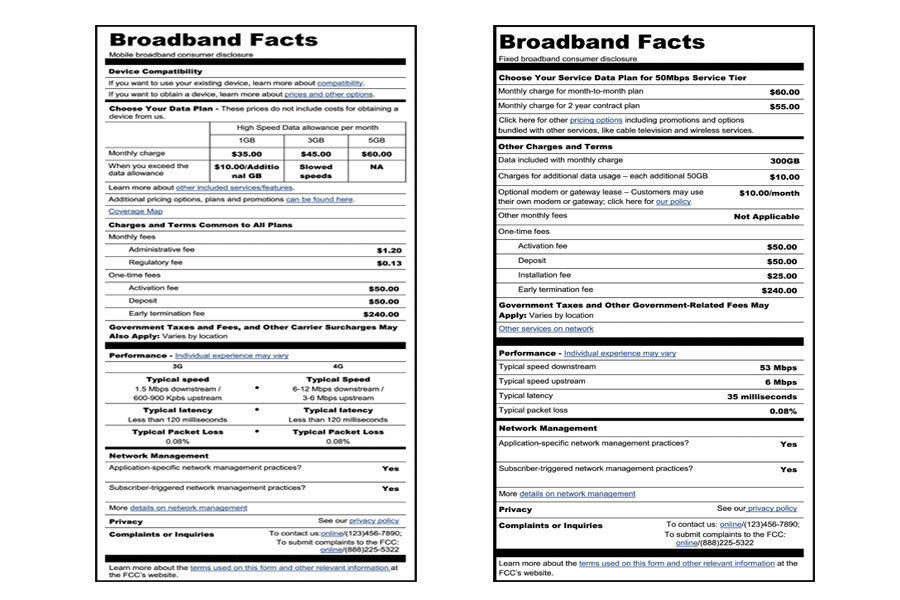New tech 'nutrition labels' help consumers shop for Internet providers
Loading...
Are consumers getting what they pay for when they shell out for high-speed Internet access?
With a new broadband labeling system modeled on food products' rectangular Nutrition Facts labels, the Federal Communications Commission wants to help prospective buyers find out.
Instead of information on calories and saturated fats, the new labels, which were introduced on Monday, reveal details on pricing, speed, data caps, and hidden fees to help consumers avoid a surprising charge on their monthly bill.
"Customers deserve to know the price they will actually pay for a service and to be fully aware of other components such as data limits and performance factors before they sign up for service," Tom Wheeler, the FCC’s Chairman, said in a press release.
The information the labels contain isn't really new, but the format may offer a closer look at how such organized lists or "shopping sheets" can help consumers. They've also been introduced in other areas, such as helping people learn more about college financial aid or pick a mortgage.
The Broadband Facts labels, which are voluntary for wired and mobile broadband providers, follow a format recommended unanimously by the FCC’s Consumer Advisory Committee. The panel includes both consumer advocates and representatives from large Internet providers and some mobile carriers, such as T-Mobile.
"If you’re going to get competition, competition, competition, you need information, information, information," Mr. Wheeler said at an event introducing the labels in Washington, the Los Angeles Times reports.
Transparency for consumers
As part of the FCC's net neutrality rules on online traffic adopted last year, Internet providers were required to disclose a variety of information to consumers on issues such as data speeds and pricing.
Internet providers who included accurate information on the new labels wouldn't be subject to regulatory action under a so-called "safe harbor" protection that was introduced last year.
While those final transparency rules must be approved by the White House's Office of Budget and Management, Internet providers can begin using the Internet labels before then, the FCC said.
The National Cable and Telecommunications Association, which includes industry giants Comcast and Time Warner, said it supported the new labels, though the group is one of several trade organizations that have challenged the FCC's net neutrality rules in court.
"In today's competitive marketplace, cable Internet providers are committed to providing consumers with accessible and relevant information about broadband services," the group said, according to the LA Times. "We appreciate this contribution by the commission to offer consumers that same information in a format they are familiar with."
But CTIA, a trade group of mobile carriers that includes T-Mobile, opposed the labels. It has also challenged the agency's net neutrality rules in a case that's currently pending before a federal court in Washington, D.C.
"While we appreciate that these labels will serve as a 'safe harbor' under the Open Internet transparency rules, CTIA members already provide disclosure and transparency as part of the Consumer Code for Wireless Service," Scott Bergmann, the group’s vice president of regulatory affairs, said in a statement.
"The competitive nature of the wireless broadband market does more for consumers than regulation can hope to achieve," he added.
It was somewhat unclear how the court challenge by the industry groups would impact the new labels.
The FCC told ArsTechnica that the new transparency rules wouldn't be included in a court ruling, though broadband groups have pushed in court filings for judges to vacate the entire order, without specifying if some parts should be maintained.
Similar to attempts to rate colleges
In some respects, the debate mirrors the Obama administration's failed attempts to impose a college ratings system.
That plan was proposed in 2013 with the idea of explicitly rating schools and shaming low-rated schools that left students with high levels of debt and little chance of making enough to pay back their student loans. But it provoked bitter opposition from many colleges and universities, especially private institutions.
After several delays, a revised version was launched last fall as a website that provides students and parents with information on colleges' annual costs, graduation rates, and salaries, without any sort of rating.
The Consumer Financial Protection Bureau (CFPB), the nation's consumer watchdog, has also partnered with the Education Department to introduce a "shopping sheet" that allows students to compare financial aid offers, along with information such as a school's graduation rate and average student loan debt. As with the broadband labels, it is voluntary for colleges.
The Bureau, which helped the FCC design its labels, hasn't explicitly taken action on Internet or TV providers that mislead consumers, such as by delivering an Internet connection at a speed lower than advertised.
But some complaints in its database refer to debt collection agencies demanding payment on behalf of Internet providers, whose names are blanked out.
"I do not feel that I owe any debt of [$210.00] because of the poor quality of Internet service provided by [the company]" one consumer in North Carolina wrote in March.
The bureau says the broadband labels could be a step forward.
"Internet access is a key gateway to economic opportunity, and the majority of Americans have broadband. Signing up for this service represents a significant financial commitment," CFPB Director Richard Cordray said at the FCC's event on Monday.
"Consumers deserve to know before they owe with clear, upfront information about the prices, risks and terms of the deal," he added.







